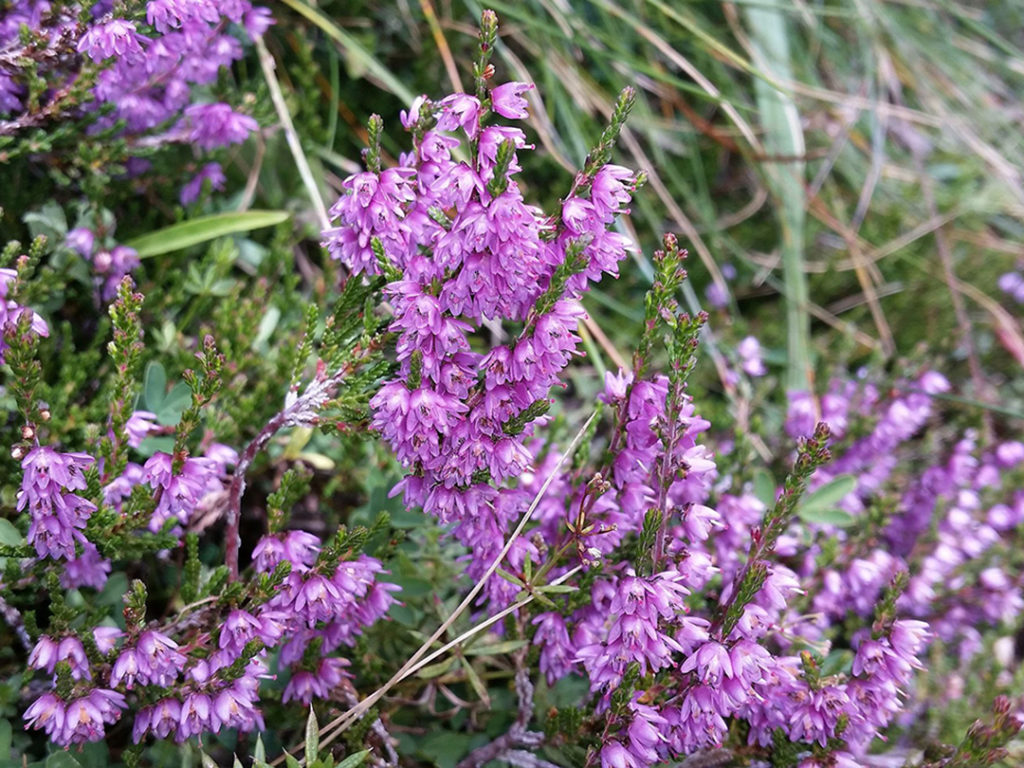
Isle of Man
Heather
Calluna

General Description / Cultural Significance
Isle of Man has been inhabited by humans since the Mesolithic Period. Although there are few trees and somewhat limited biodiversity, there are abundant flowers and the country is covered in heather. The Isle of Man reports that heather covers 11 percent of the land, and 71 percent of that is in public ownership. Calluna vulgaris is a native perennial evergreen beloved by the people and by the local bees. Special honey from Isle of Man is therefore scented with heather. Heather grows on peat bogs and when the peat is burned for heat, its distinctive scent can be recognized as it fills the air. In late summer and fall, heather is violet-colored, and its scent is noticeable throughout the island. The blooming heather ablaze on the coastline of Isle of Man is an iconic image. Another well-known species of heather is the cross-leaved heath or rose heather, Erica tetralix, which also grows in the boggy areas of the country. An infusion of heather blossoms has been made for centuries. Calluna vulgaris is rich in bioactive compounds including phenolic acids. The plant has antioxidant, anti-inflammatory, and antiproliferative properties.
Climate Change/Conservation Status
Isle of Man acknowledges that the effects of climate change are already happening to the environment and to the economy. The island is already experiencing sea level rise and an increase in temperatures, as well as an increased frequency of severe storms and storm surges.
The Isle of Man government wishes to maximize the natural capacities of their hill land and peat bogs as a way to reduce the impact of climate change, as they store carbon dioxide. As the Manx say, the uplands are “an iconic part of our landscape and heritage.” The hill lands collect and filter their drinking water, help retain water from rainfall, slow its passage into rivers and streams, and reduce downstream flood risk. Thus, they are emphasizing sustainable management of this area in particular to ensure that it retains its functions well into the future to the benefit of the island’s inhabitants. An area once appreciated by the country for its beauty is now identified as an area most important to their sustainability. Because heather grows on peat bogs, sustainable management of those areas also impacts the plant.
The government of Isle of Man is committed to achieving net zero emissions by 2050.
Alternate Names
Ling
Sources
Douglas Public Library, Isle of Man; The Perfumery of Saint Johns, Isle of Man.
Dróżdż, P., & Sentkowska, A., 2016. Heather flowers as a source of phenolic acids – Evaluation of solvent effect and antioxidant capacity. Research Gate. [website]
Hutchins, A., 2006. The Isle of Man Climate Change Scoping Study. Climate Risk Management.
John Bowring, Douglas Public Library, Isle of Man; Pete Matthews of The Perfumery at Saint Johns, Isle of Man. This statement can be found on the World Sensorium original website.
Manx Radio, 2006. Manx Heather. Manx Telecom. [website]
The Official Isle of Man Government Website, 2013. Manx Upland Steering Group. Crown Copyright. [website]
Vogl, S., et al., 2013. Ethnopharmacological in vitro studies on Austria’s folk medicine — An unexplored lore in vitro anti-inflammatory activities of 71 Austrian traditional herbal drugs. J Ethnopharmacol, [website] (149)3. DOI: 10.1016/j.jep.2013.06.007

